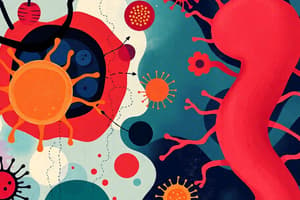Podcast
Questions and Answers
How are transient microbes typically acquired?
How are transient microbes typically acquired?
- From permanent colonization in the host.
- From food and water sources.
- Through surgical procedures.
- By interaction with other humans or the environment. (correct)
What role do resident microbes play in the human body?
What role do resident microbes play in the human body?
- They cause infections and diseases.
- They provide natural immunity against certain infections. (correct)
- They create a hostile environment for pathogens.
- They are harmful and can be easily eliminated.
Under what conditions might resident microbes become pathogenic?
Under what conditions might resident microbes become pathogenic?
- If they are introduced to a different site within the same individual. (correct)
- When they compete with transient microbes.
- During surgical scrubbing techniques.
- After long-term coexistence with the host.
What occurs more frequently in healthy individuals regarding resident and transient microbes?
What occurs more frequently in healthy individuals regarding resident and transient microbes?
Which statement correctly differentiates between colonization and infection?
Which statement correctly differentiates between colonization and infection?
Why are transient microbes not usually harmful to a healthy individual?
Why are transient microbes not usually harmful to a healthy individual?
What occurs when the interaction between transient and resident microbes is harmful?
What occurs when the interaction between transient and resident microbes is harmful?
Which statement about the ecosystem of resident and transient microbes is true?
Which statement about the ecosystem of resident and transient microbes is true?
What is a characteristic symptom of clinical infection?
What is a characteristic symptom of clinical infection?
Endogenous infections occur when normal flora is transmitted to
Endogenous infections occur when normal flora is transmitted to
Which component is NOT part of microbiology laboratory reports?
Which component is NOT part of microbiology laboratory reports?
Which of the following best defines infectious disease?
Which of the following best defines infectious disease?
What role do symptoms play in differentiating colonization from infection?
What role do symptoms play in differentiating colonization from infection?
Which condition can result in the overgrowth of an organism like C. difficile?
Which condition can result in the overgrowth of an organism like C. difficile?
In laboratory analysis, what must be considered alongside bacterial culture results to determine infection?
In laboratory analysis, what must be considered alongside bacterial culture results to determine infection?
What distinguishes resident microbes from transient microbes?
What distinguishes resident microbes from transient microbes?
What term describes the organisms that colonize without causing disease?
What term describes the organisms that colonize without causing disease?
Which term describes the presence of microorganisms in the body that cause harm?
Which term describes the presence of microorganisms in the body that cause harm?
Which of the following best defines 'virulence'?
Which of the following best defines 'virulence'?
What are the three types of transmission-based precautions?
What are the three types of transmission-based precautions?
In which scenario would transient flora be likely to shed in a short period?
In which scenario would transient flora be likely to shed in a short period?
What does 'reservoir' refer to in the context of infectious diseases?
What does 'reservoir' refer to in the context of infectious diseases?
Which of the following statements best describes standard precautions?
Which of the following statements best describes standard precautions?
Which anatomical sites in the body are generally considered sterile?
Which anatomical sites in the body are generally considered sterile?
Flashcards are hidden until you start studying
Study Notes
Infectious Diseases
- Result from the invasion of the body by harmful microorganisms, potentially leading to death.
Key Terms
- Normal Flora: Nonpathogenic organisms that persistently colonize a host, providing benefits such as competition with pathogens and aiding digestion.
- Reservoir: Any living entity or location that allows microorganisms to thrive and spread.
- Pathogenic: Refers to organisms capable of causing disease.
- Standard Precautions: A safety strategy treating all patients as if they may carry infectious agents; includes barrier precautions for healthcare interactions.
- Susceptible: Lacking immunity to specific pathogens, making an individual more vulnerable to infection.
- Transient Flora: Short-lived organisms that can be easily eliminated through hygiene practices.
- Transmission-Based Precautions: Additional precautions beyond standard measures for controlling infections through airborne, droplet, or contact routes.
- Virulence: The degree of pathogenicity of a microorganism.
Colonization, Infection, and Disease
- Microorganisms continuously interact with their environment; most body sites are not sterile, with exceptions like the brain and blood.
- Normal flora compete with potential pathogens and play various symbiotic roles, contributing to a complex microbial ecosystem.
Resident vs Transient Microbes
- Resident Microbes (Endogenous): Naturally occurring bacteria in the body that provide immunity and remain unless removed by surgical scrub.
- Transient Microbes (Exogenous): Acquired through interactions with other people or environments; can be washed away but may cause opportunistic infections.
Colonization vs Infection
- Colonization typically does not cause disease in healthy individuals; pathogens can emerge if the microbes are introduced to non-native sites (e.g., E. coli causing UTI).
- Distinguishing colonization from infection requires clinical evaluation; symptoms may include pain, fever, and significant bacterial levels in lab tests.
Infectious Disease Definition
- Characterized by a decline in the host's wellness due to infection; not all infectious diseases are communicable.
Microbiology Laboratory Reports
- Essential for diagnosing bacterial infections, typically consisting of:
- Smear and stain results.
- Culture results identifying the organism.
- Sensitivity testing for antimicrobial susceptibility.
Endogenous Infections
- Occur when normal flora moves to inappropriate anatomical sites (e.g., UTI) or when antibiotics disrupt natural balances (e.g., C. difficile overgrowth).
Studying That Suits You
Use AI to generate personalized quizzes and flashcards to suit your learning preferences.




